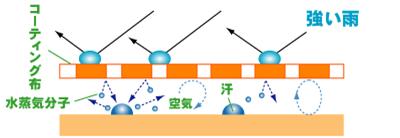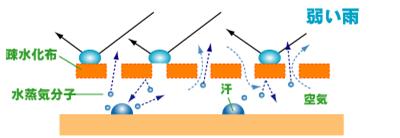Information center
![]()
FINETNC DATAROOM
About water-repellent processing
Author
화인Tnc
Date
2019-01-18 16:23
Views
587
There are many clothes of water-repellency including skiwear, wind jackets and coats. Water repellency standards are precisely defined and it has its own signs on clothing. Only the verified brands can get water-repellency signs as to protect customers.
This page will explain on what “water-repellency” is.
Difference between “waterproof” and “water-repellency”
“Waterproof”
Waterproof is to prevent water leakage or permeation thoroughly by coating vinyl or synthetic rubbers with paraffin. It doesn’t let in any air or vapor, so it gets easily hot, which is a serious defect. To add up, it is non-ventilating.

Waterproof = no niche for water to pass by
“Water-repellency”
Water-repellency is to bounce off water by rolling water molecule into a sphere. Fabrics are processed to reduce surface tension in order to bounce off water in a droplet form. It has niches between fibers, so air and vapor can pass through the fabric. It can be therefore kept cooler than waterproof clothing. In this sense, water-repellency is ventilating.

Water-repellency = niches for vapor and air molecules
About handling attention signs
Japan Apparel Industry Association has its own “handling attention signs” criteria for apparel industries.
3 signs of water-repellency are included in the guide, in order to prevent differences being made by brands.
So, it is easy to understand “water repellency” if we closely look at the explanation on those 3 signs.
Water-repellency processed. Not totally waterproof, be cautious for strong rain.
Water-repellency processing leaves niches between fibers, which is different from totally waterproof vinyl jumpers, so it is impossible to completely prevent permeation of water.
Some customers misunderstand this concept and they often misunderstand that the waterproof function is lost after laundry.
“Water-repellncy” only bounces off water and cannot prevent permeation of water.
Dry-cleaning weakens water-repellency, so ask for water-repellency processing when taking the laundry to laundromat. You can also use water-repellent spray in market.
Products including raincoat use lypophobic materials for its fabric to prevent soaking.
But, if water-repellency processed fabric is dry-cleaned or washed, then the function may deteriorate. Surfactants in detergent remains on clothing to make it hydrophilic.
Becoming hydrophilic weakens water-repellency. If you do not use “water-repellency processing service”, the function will remain weakened so you must use the service if visiting laundromat. To add up, detergents are thoroughly rinsed before water-repellency processing.
Also, water-repellent sprays in market are not easily processed due to some stains, so it is recommended to use the service if possible.
avoid using fluorine solvent.
Fluorine solvent react more strongly to water-repellency agents than other solvents, only to reduce the function.
This page will explain on what “water-repellency” is.
Difference between “waterproof” and “water-repellency”
“Waterproof”
Waterproof is to prevent water leakage or permeation thoroughly by coating vinyl or synthetic rubbers with paraffin. It doesn’t let in any air or vapor, so it gets easily hot, which is a serious defect. To add up, it is non-ventilating.

Waterproof = no niche for water to pass by
“Water-repellency”
Water-repellency is to bounce off water by rolling water molecule into a sphere. Fabrics are processed to reduce surface tension in order to bounce off water in a droplet form. It has niches between fibers, so air and vapor can pass through the fabric. It can be therefore kept cooler than waterproof clothing. In this sense, water-repellency is ventilating.

Water-repellency = niches for vapor and air molecules
About handling attention signs
Japan Apparel Industry Association has its own “handling attention signs” criteria for apparel industries.
3 signs of water-repellency are included in the guide, in order to prevent differences being made by brands.
So, it is easy to understand “water repellency” if we closely look at the explanation on those 3 signs.
Water-repellency processed. Not totally waterproof, be cautious for strong rain.
Water-repellency processing leaves niches between fibers, which is different from totally waterproof vinyl jumpers, so it is impossible to completely prevent permeation of water.
Some customers misunderstand this concept and they often misunderstand that the waterproof function is lost after laundry.
“Water-repellncy” only bounces off water and cannot prevent permeation of water.
Dry-cleaning weakens water-repellency, so ask for water-repellency processing when taking the laundry to laundromat. You can also use water-repellent spray in market.
Products including raincoat use lypophobic materials for its fabric to prevent soaking.
But, if water-repellency processed fabric is dry-cleaned or washed, then the function may deteriorate. Surfactants in detergent remains on clothing to make it hydrophilic.
Becoming hydrophilic weakens water-repellency. If you do not use “water-repellency processing service”, the function will remain weakened so you must use the service if visiting laundromat. To add up, detergents are thoroughly rinsed before water-repellency processing.
Also, water-repellent sprays in market are not easily processed due to some stains, so it is recommended to use the service if possible.
avoid using fluorine solvent.
Fluorine solvent react more strongly to water-repellency agents than other solvents, only to reduce the function.









